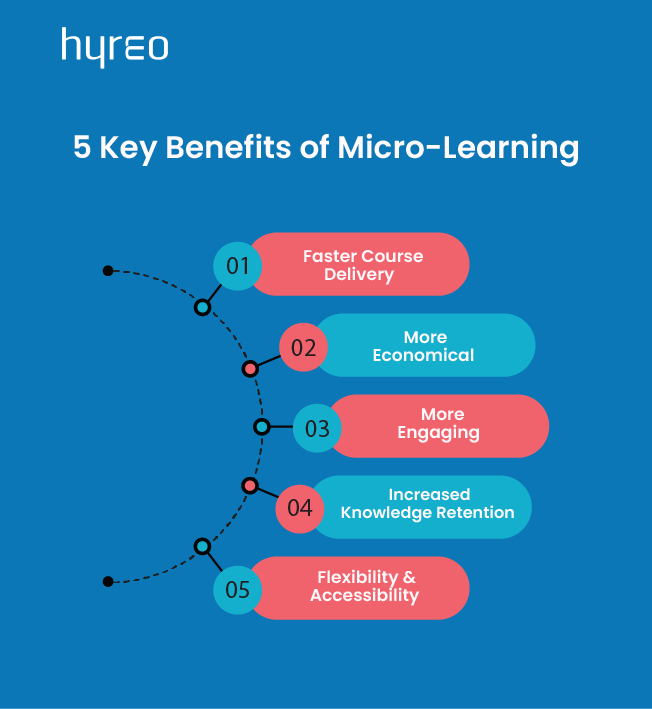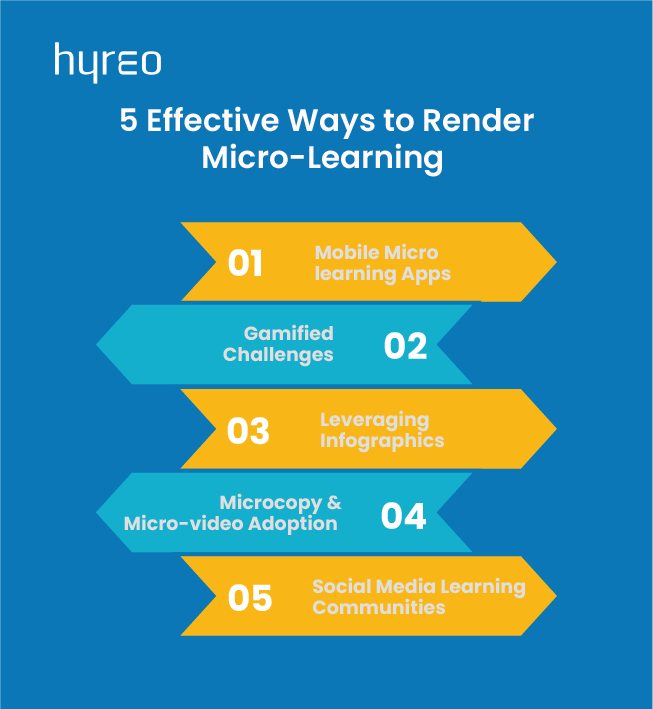Key Highlights
- Micro-learning involves using small, bite-sized content pieces to teach and train employees and ultimately reach the goal intended by the training and development programs
- Micro-learning lessons are short, quick, and easy to understand and help to engage learners, improve information retention and recall, and increase their productivity at work
- Micro-learning lessons should be developed in sync with best practices such as checking the right fit, reworking the existing courses, skimming the excess flab from the content, employing gamification techniques, and adding recurring content for increasing retention value
Good things come in small packages, and so does micro-learning. Micro-learning renders employees with small doses or tiny bursts of information that they can utilize and comprehend easily and in a timely fashion.
Micro-learning is an alternative method to impart training to employees against conventional, content-heavy e-learning classes and lectures that demand huge time and attention on the part of the learners. It is short, quick, and easy to grab.
Hermann Ebbinghaus says in his concept of the forgetting curve, that people have a short attention span and tend to forget 80% of the knowledge they learn within a month. Ebbinghaus found that the issue was more rampant when people tried learning large amounts of information.
Micro-learning helps to break down large pieces of content into retainable bits of information and improve learners’ productivity and retention capacity. This article dives into what micro-learning is, its benefits, challenges, examples, and best practices.
What is Micro-Learning?
Micro-learning refers to an approach where learning takes place through small doses of information or little pieces of content that can be comprehended in a short time. A typical micro-learning lesson may last as long as 10 minutes.
Micro-learning is suited for on-the-job training where employees may be provided with these lessons as and when the need arises. The employees then learn and apply the lesson during the course of work.
According to Forbes, microlearning is grounded in cognitive science, where spaced repetition and breaking topics into smaller segments have been shown to enhance memory retention.Micro-learning involves narrowing down a lesson into smaller, simpler sub-topics that require little effort on the part of the employees to retain and recollect whenever needed. Micro-learning is suitable for mobile learning and can involve training quizzes, videos, flashcards, content messages, emails, etc.
5 Benefits of Micro-Learning
As the human attention span shrinks further and employee work schedules get busier, you cannot but appreciate the value micro-learning brings to the learner’s table. It is a near-perfect training model to ease out all kinds of training, including onboarding, compliance, or skills training.
Some of the benefits include:

#1 Faster delivery times
Trainers and educators can add dozens of course units in a single module. They can also keep upgrading them to meet changing business goals and training standards without having to redo the entire course structure. These courses have shorter delivery times as the learners aren’t required to spend hours on training. They can learn on the go and apply the same at work simultaneously.
#2 More economical
Creating such micro-learning courses doesn’t require huge resources and also needs a lesser number of instructors. The course is economical to build from scratch as no specialized micro-learning tools may be required to create the content.
#3 More engaging
Employees aren’t able to fully and fruitfully engage with conventional training programs while at work because they don’t have enough time to do so. Micro-learning overcomes the time barrier to provide lessons that are less than 10 minutes yet fulfill the learning needs. The less time an employee needs to spend at training, the better it is.
#4 Builds knowledge retention
The micro-learning theory stresses small lessons that are repeated over and over again for better retention and post-lesson quizzes and tests that increase the recall quotient of the completed lesson. Instead of forgetting the content over time, a learner is able to remember the lesson by repeating it regularly on the app they might be using to take lessons on their mobile phones.
#5 Brings flexibility
Micro-learning offers flexibility in terms of the way in which the lessons are delivered and can be accessed from anywhere and at any time the workers desire to learn them. It can cover any subject matter that has the potential to be broken down into bite-sized lessons for a better understanding. Even complex topics can be broken down into small lessons to ease up the load and pressure of learning everything all at once.
What are the constraints or boundaries of microlearning?
Micro-learning comes with its own set of challenges and may not be suitable for every kind of subject matter or learning mode. Some of the common challenges learners and trainers may face in micro-earning include the following:
#1 Unsuitable for complex concepts and topics
Micro-learning is not ideal in cases when the topics are complex, and breaking them down into small lessons would be difficult or impractical. This is because the lessons won’t add much value to the understanding of a complex topic or might require more effort to build a micro-learning lesson set out of the complex topic.
#2 Time-consuming and resource-extensive
In certain cases, when the subject matter is extensive and requires lengthy explanations and in-person lectures, it wouldn’t be feasible to employ efforts and resources into building a micro-learning module for such a matter. On the other hand, forcing bite-sized modules to replace lengthy explanations may be heavy on the pockets and won’t add much to the understanding of the employees.
#3 Difficulty in scaling personalized content
Personalized learning modules for every employee may become a tedious and time-consuming job. Though micro-learning courses contain very short content pieces, the number of such pieces is higher than in regular courses.
The entire company training schedule might result in thousands of such content pieces, which might get difficult to manage or scale to suit different employee needs. It might become a nightmare for instructional designers to go through each piece of content. Personalize and organize it before directing it to the right individuals.
For instance, people with disabilities would require specialized formatting and optimizing to be able to use micro lessons to their full advantage. However, it would be an added task for the designers to build the courses as per the best practices and accessibility standards.
Microlearning Best Practices
All organizations should have a code of conduct and a set of best practices that instructional designers need to follow when designing micro-learning course content for training purposes.
Some of the standard best practices include the following:
#1 Check whether it is the right fit for a particular use case
If the subject matter is complex, lengthy, and requires in-person training, micro-learning may not be best suited. If the training for a task cannot be squeezed into 10 minutes or cannot be taught using an e-course or slideshow, micro-training can be used as a complementary training approach, supporting the main training module.
#2 Breakdown existing course content
Instead of creating an entirely new micro-learning curriculum for your training courses and materials, break down existing courses into smaller modules. The smaller parts can be reworked to fit the modules. However, avoid pasting chunks of the previous training modules as micro-learning lessons. Keep the lessons short, engaging, and focused.
#3 Use gamification to support engagement
Adding gamification elements like quizzes, badges, awards, leaderboards, etc., help to boost engagement in learning by stimulating a game-like learning environment. Such micro-learning modules also give a boost to employees for completing certain levels in the course.
#4 Multimedia tools to increase interaction
Using multimedia tools like photos, videos, illustrations, and animations to keep the learner’s interest up. The videos and animations should be short and add value to the modules and shouldn’t just be for beautification purposes. These add-ons enhance the learning experience by bringing the auditory and visual senses together.
#5 Provide universal access
Employees must be able to access the micro lessons at any time and use any device like smartphones or tablets with a single login. Also, make sure the employees have access to lesson-end tests or revision quizzes to review what they learned during the lesson.
Examples of Microlearning

#1 Micro-learning apps
Mobile-based micro-learning apps such as Google, TED, Headspace, Youtube, Lasting, Word of the Day, etc., give employees the freedom to learn lessons on the go.
#2 Challenges and Games
Micro-learning games and challenges can include an award, benefit, badge, or incentive at the end of every lesson and scale as the learner scores higher marks.
Some examples of games and challenges that can boost engagement in micro-learning modules include multiple-question quizzes, flashcards, polls, simulations, and audio recordings of answers to a pre-written set of questions, among others.
#3 Infographics
65% of the human population are visual learners. Short lessons accompanied by infographics focusing on key points and statistics in the lesson or graphs, illustrations, and the use of other visual tools within the micro lesson content can help learners to retain and recollect the lessons better.
Some examples of infographics could be those related to statistical figures, information, timeline, process, hierarchy, comparison, or even geography.
#4 Microcopy and videos
A micro-copy is a short, targeted message relevant to a particular context, such as an error message, e-commerce hints, or contact form explainers, that help users learn side by side.
Micro-learning videos, such as explainer videos, micro-lectures, whiteboard animations, text-based animations, etc., are designed to meet the goal of a specific learning outcome. These videos often make up a small part of a longer learning path.
#5 Social media
Social media platforms like Twitter, LinkedIn, Reddit, Wall Street Journal, etc., offer small snippets of news and information on the kind of content that employees subscribe to or follow.
They can also serve as online learning communities where micro-learning lessons, videos, and tests are shared and discussed by the members.
Wrap Up
Micro-learning and training activities can be a boon for employees toiling themselves on modules that are far too long to grab in one go or too complex to understand or retain, given the multiple sub-lessons that might make a single module.
Micro-learning modules, with nugget-sized learning modules and curriculum, can unburden the employees of incessant training routines. Instead, the small lessons and videos will help them retain, recollect, and apply their learnings at work while making the training more interactive and engaging.
Also read: Hire for attitude, train for skills!
Also read: Candidate Engagement – a guide
Also read: Success Mantra for Candidate Recruiter Relationship
Also read: Understanding recruiter training and why you really need it?
FAQs on Micro-learning
What is the purpose of micro-learning?
Micro-learning employs the use of short lessons in the form of content, video, slide, or infographics to help employees enhance their learning and performance most efficiently.
What is an example of micro-learning?
There are many examples of micro-learning. However, the most widely used examples include micro-lessons and micro-videos that contain a small chunk of information explained with images and illustrations to help the learner understand, retain, and recollect the lesson later.
What is the difference between micro-learning and e-learning?
E-learning modules are vast and expansive in their approach and may include an entire university course to a simple module on how to apply for a job using a job application. Micro-learning, on the other hand, uses a nugget-sized information approach and renders small learning units that employees can learn and apply during work.
What’s the standard time limit of a micro-learning lesson?
The rule of thumb says that no micro-learning lesson should be longer than 10 minutes. However, any lesson above one minute but less than 10 minutes (with regard to exceptions) can be considered a micro-lesson.
What is the micro-learning theory?
Micro-learning theory refers to the way of teaching content to learners in small units, especially at the point of need. The small units of lessons are highly-contextual and focused on specific learning outcomes helping learners to stay in control of what, when, and how they are learning.




